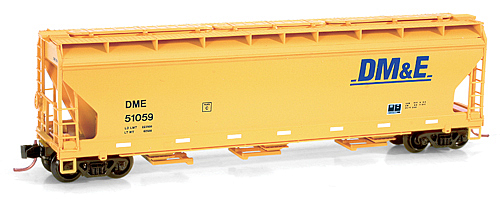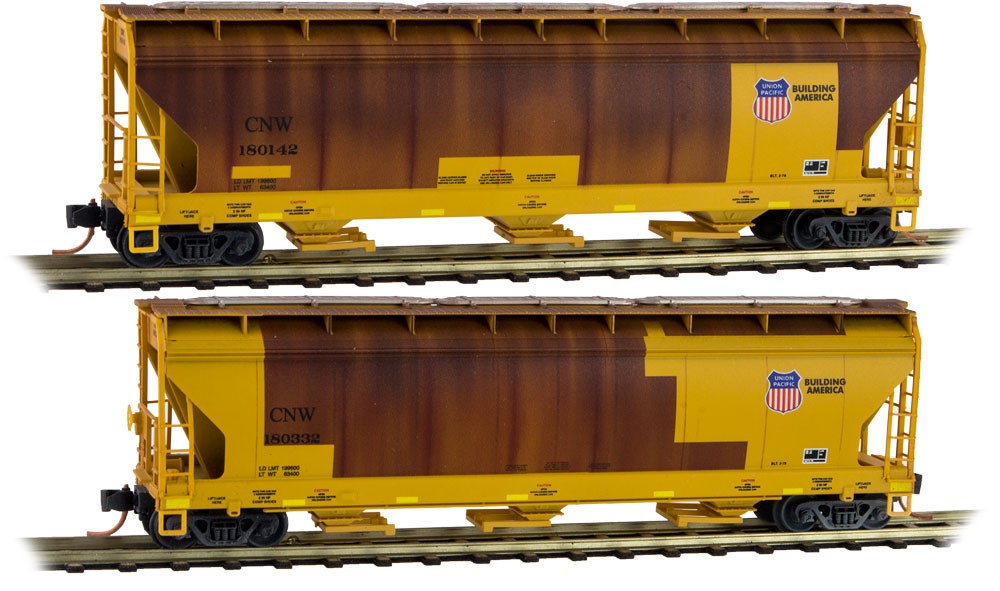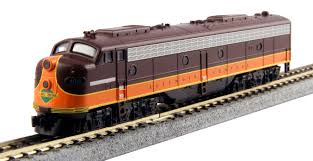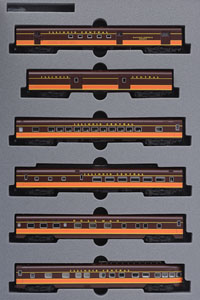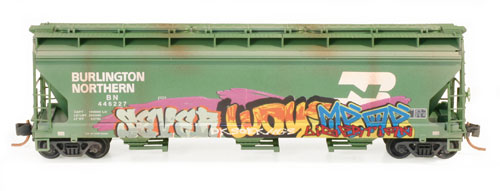Prototype History: Production of the 4650-cubic foot 3-bay cars began in 1964. ACF built 2504 examples at Huntington, WV, between 1964 and 1972. The ACF 4650 c.f. 3-bay hopper was the same height and width as the 5250 c.f. 4-bay car but several feet shorter in length (and only had 3 bays!). Some railroads that were not concerned about having the larger plate C clearance 4650cf cars (which could not be used on all branchlines or at all loading facilities) opted for large fleets of 4650cf cars instead of 4600cf. UP and SP were two such railroads (all of the current UP 4600cf cars came from either MP or C&NW heritage).
Hatches: 6 30", 6 20", 3 pressed steel elongated (SP, SSW, 3 piece pressed steel continuous or 4 piece FRP continuous. Outlets: Several types of bolted or welded on outlets are used. Uses: Grain, soda ash, platic pellets. Trucks: 77 ton friction or roller bearing. 86 had 100 ton roller bearing.
Hatches: 6 30", 6 20", 3 pressed steel elongated (SP, SSW, 3 piece pressed steel continuous or 4 piece FRP continuous. Outlets: Several types of bolted or welded on outlets are used. Uses: Grain, soda ash, platic pellets. Trucks: 77 ton friction or roller bearing. 86 had 100 ton roller bearing.
Road Name History: The DM&E launched in 1986 as a spin-off of Chicago & North Western. The mainline ran from Winona, Minnesota (where there are Mississippi River docks) west to Rochester, Mankato, then onto Pierre and Rapid City, South Dakota. At that point the line split with one leg headed west to Colony, Wyoming, and the other leg headed south to Crawford, Nebraska. There were also a few other branchlines. Total mileage was 965 miles (putting it between Chicago & Eastern Illinois and Montana Rail Link in relative size.)
Operations began with 39 locomotives, mostly rebuilt SD9’s of Milwaukee Road heritage. Eventually DM&E dumped these first generation engines and in later years had a fleet of 69 rebuilt SD40-2’s, GP40-2’s, GP38-2’s, and a few one-offs. They also had about 5,000 freight cars, mostly grain hoppers.
In 1997, DM&E announced their intention to build a line to the huge coal reserves in Wyoming’s Powder River Basin. The project would have included rebuilding nearly the entire mainline plus building a new (and long) branch to reach the Basin. It would have been the biggest new construction since Great Northern’s Oregon Trunk in 1931. They did receive permission from the government but NIMBY opposition dragged out the start of construction for many years.
In 2008, The Dakota Minnesota & Eastern and sister road Iowa Chicago & Eastern were purchased by Canadian Pacific. After a bit of study, CPR wisely backed away from the Powder River Project.
Operations began with 39 locomotives, mostly rebuilt SD9’s of Milwaukee Road heritage. Eventually DM&E dumped these first generation engines and in later years had a fleet of 69 rebuilt SD40-2’s, GP40-2’s, GP38-2’s, and a few one-offs. They also had about 5,000 freight cars, mostly grain hoppers.
In 1997, DM&E announced their intention to build a line to the huge coal reserves in Wyoming’s Powder River Basin. The project would have included rebuilding nearly the entire mainline plus building a new (and long) branch to reach the Basin. It would have been the biggest new construction since Great Northern’s Oregon Trunk in 1931. They did receive permission from the government but NIMBY opposition dragged out the start of construction for many years.
In 2008, The Dakota Minnesota & Eastern and sister road Iowa Chicago & Eastern were purchased by Canadian Pacific. After a bit of study, CPR wisely backed away from the Powder River Project.
Brand/Importer Information: Micro-Trains is the brand name used by both Kadee Quality Products and Micro-Trains Line. For a history of the relationship between the brand and the two companies, please consult our Micro-Trains Collector's Guide.
Manufacturer Information:  Micro-Trains Line split off from Kadee Quality Products in 1990. Kadee Quality Products originally got involved in N-Scale by producing a scaled-down version of their successful HO Magne-Matic knuckle coupler system. This coupler was superior to the ubiquitous 'Rapido' style coupler due to two primary factors: superior realistic appearance and the ability to automatically uncouple when stopped over a magnet embedded in a section of track. The success of these couplers in N-Scale quickly translated to the production of trucks, wheels and in 1972 a release of ready-to-run box cars.
Micro-Trains Line split off from Kadee Quality Products in 1990. Kadee Quality Products originally got involved in N-Scale by producing a scaled-down version of their successful HO Magne-Matic knuckle coupler system. This coupler was superior to the ubiquitous 'Rapido' style coupler due to two primary factors: superior realistic appearance and the ability to automatically uncouple when stopped over a magnet embedded in a section of track. The success of these couplers in N-Scale quickly translated to the production of trucks, wheels and in 1972 a release of ready-to-run box cars.
Micro-Trains Line Co. split off from Kadee in 1990 to form a completely independent company. For this reason, products from this company can appear with labels from both enterprises. Due to the nature of production idiosyncrasies and various random factors, the rolling stock from Micro-Trains can have all sorts of interesting variations in both their packaging as well as the products themselves. When acquiring an MTL product it is very important to understand these important production variations that can greatly enhance (or decrease) the value of your purchase.
Please consult our Micro-Trains Collector's Guide

Micro-Trains Line Co. split off from Kadee in 1990 to form a completely independent company. For this reason, products from this company can appear with labels from both enterprises. Due to the nature of production idiosyncrasies and various random factors, the rolling stock from Micro-Trains can have all sorts of interesting variations in both their packaging as well as the products themselves. When acquiring an MTL product it is very important to understand these important production variations that can greatly enhance (or decrease) the value of your purchase.
Please consult our Micro-Trains Collector's Guide
Item created by: Lethe on 2015-05-31 17:46:30. Last edited by George on 2024-01-26 20:28:50
If you see errors or missing data in this entry, please feel free to log in and edit it. Anyone with a Gmail account can log in instantly.
If you see errors or missing data in this entry, please feel free to log in and edit it. Anyone with a Gmail account can log in instantly.


